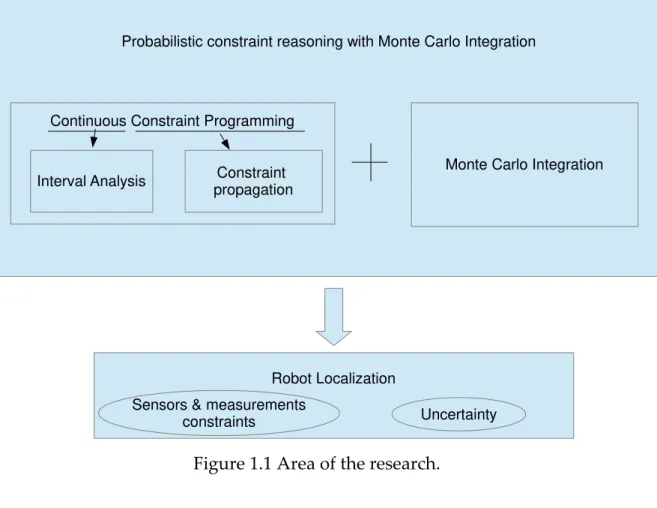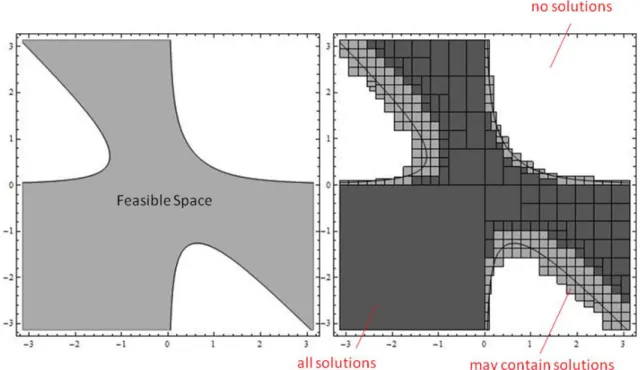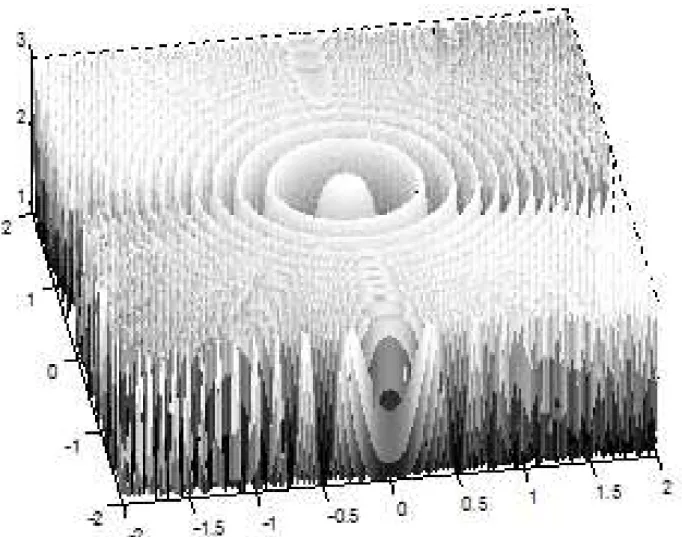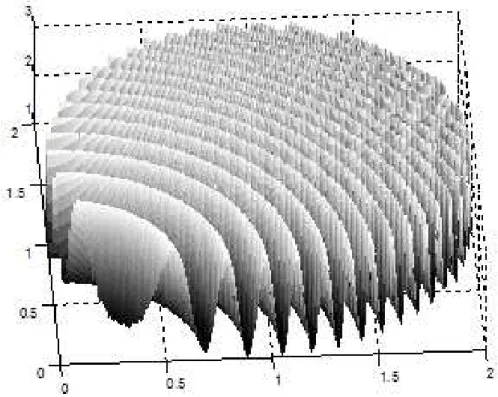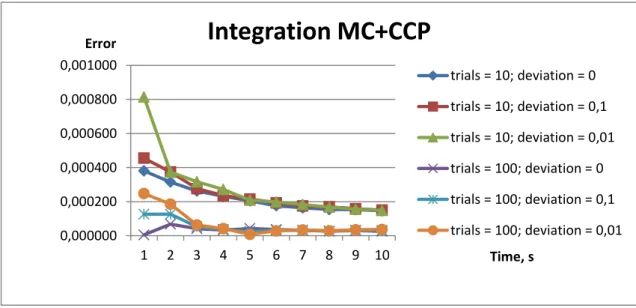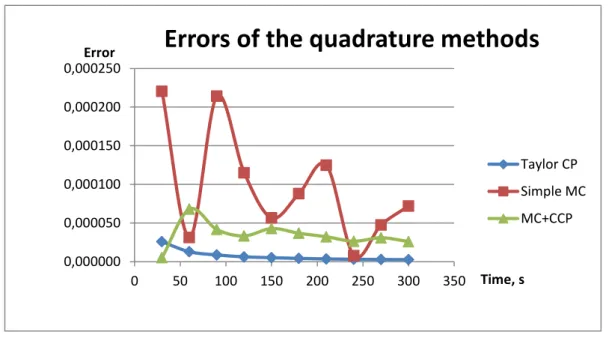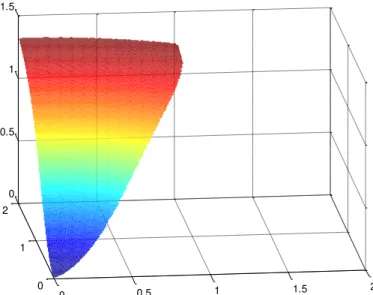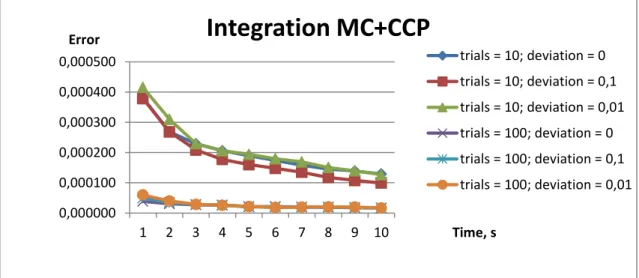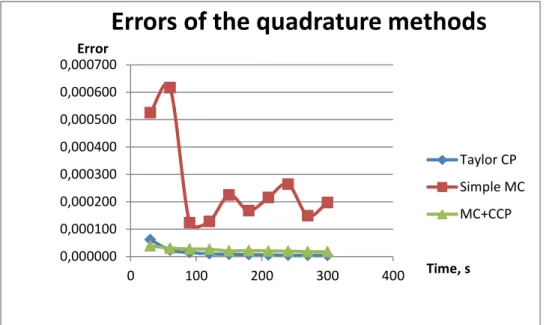Olga Meshcheryakova
Mestrado em Engenharia Electrotécnica,
Sistemas e Computadores
Probabilistic constraint reasoning
with Monte Carlo integration
to Robot Localization
Dissertação para obtenção do Grau de Mestre em
Engenharia Electrotécnica, Sistemas e Computadores
Orientador: Pedro Alexandre da Costa Sousa, Professor, FCT-UNL
Co-orientador: Jorge Carlos Ferreira Rodrigues da Cruz, Professor, FCT-UNL
Júri
Presidente: João Paulo Branquinho Pimentão Arguente(s): José António Barata de Oliveira
Pedro Alexandre da Costa Sousa
iii
Probabilistic constraint reasoning with Monte Carlo integration to Robot Localization
Copyright © Olga Meshcheryakova, Faculdade de Ciências e Tecnologia, Universidade Nova de Lisboa.
v
Acknowledgements
I would like to express my deepest gratitude to Professor Jorge Cruz,
who gave me guidance, suggestions and help, which was decisive for the work.
I am very grateful to Professor Pedro Sousa, who gave me motivation and
provided all kinds of support. Also, I would like to thank Marco Correia, who
helped me in the implementation and gave valuable advices.
Moreover, I want to express special thanks to my family and friends who
vii
Resumo
Este trabalho estuda a combinação de raciocínio seguro e probabilístico através da hibridação de técnicas de integração de Monte Carlo com programação por restrições em domínios contínuos. Na programação restrição contínuaexistem vari{veis que vãosobre os domínioscontínuos (representados como intervalos), juntamente com as restrições sobre elas (as relações entre as vari{veis) e o objetivo é encontrar valores para as vari{veis que satisfazem todas as restrições (cen{rios consistentes). Algoritmos programação por restrições "branch-and-prune" produzem resultados de todos os cen{rios consistentes. Algoritmos especiais propostos para o raciocínioprobabilístico por restrição calculam a probabilidade de conjuntos de cen{rios consistentes que implicam o c{lculo de um integral sobre estes conjuntos (quadratura). Neste
trabalho, propomos estender os algoritmos "branch-and-prune" com técnicas de integração de Monte Carlo para calcular essas probabilidades. Esta abordagem pode ser útilna {rea da robótica para problemas de localização. As abordagens tradicionais são baseadas em técnicas probabilísticas que buscam o cen{rio mais prov{vel, que não pode satisfazer as restrições do modelo. Nós mostramos como aplicar a nossa abordagem para lidar com este problema e fornecer
funcionalidade em tempo real.
ix
Abstract
This work studies the combination of safe and probabilistic reasoning
through the hybridization of Monte Carlo integration techniques with
continuous constraint programming. In continuous constraint programming
there are variables ranging over continuous domains (represented as intervals)
together with constraints over them (relations between variables) and the goal
is to find values for those variables that satisfy all the constraints (consistent
scenarios). Constraint programming “branch-and-prune” algorithms produce
safe enclosures of all consistent scenarios. Special proposed algorithms for
probabilistic constraint reasoning compute the probability of sets of consistent
scenarios which imply the calculation of an integral over these sets
(quadrature). In this work we propose to extend the “branch-and-prune”
algorithms with Monte Carlo integration techniques to compute such
probabilities. This approach can be useful in robotics for localization problems.
Traditional approaches are based on probabilistic techniques that search the
most likely scenario, which may not satisfy the model constraints. We show
how to apply our approach in order to cope with this problem and provide
functionality in real time.
Keywords: Continuous Constraint Programming, Interval Analysis,
xi
Contents
1. INTRODUCTION ... 1
1.1 GOALS ... 2
1.2 AREA... 2
1.3 CONTRIBUTIONS ... 6
1.4 SCHEME OF THE DOCUMENT ... 6
2. STATE OF THE ART ... 9
2.1 CONTINUOUS CONSTRAINT PROGRAMMING ... 10
2.1.1 Interval Analysis ... 11
2.1.2 Constraint Reasoning with Continuous Domains ... 14
2.2 PROBABILISTIC CONSTRAINT REASONING ... 16
2.3 MONTE CARLO QUADRATURE METHODS ... 18
2.4 APPLICATION OF CONSTRAINT PROGRAMMING AND INTERVAL ANALYSIS TO ROBOTICS ... 23
2.5 SUMMARY ... 25
3. PROBABILISTIC REASONING WITH MONTE CARLO INTEGRATION ... 27
3.1 PROBABILISTIC CONSTRAINT REASONING ... 28
3.2 METHODS AND ALGORITHMS OF MONTE CARLO INTEGRATION .. 33
3.3 EXPERIMENTAL RESULTS ... 37
3.3.1 Experiment 1 ... 38
3.3.2 Experiment 2 ... 43
3.3.3 Experiment 3 ... 45
3.4 COMPARISON OF THE METHODS ... 48
3.5 CONCLUSION ... 49
xii
4.1 MOBILE SERVICE ROBOTS ... 52
4.2 SIMULTANEOUS LOCALIZATION AND MAPPING METHODS ... 54
4.3 APPLICATION OF CONSTRAINT REASONING TO ROBOT LOCALIZATION ... 59
4.3.1 Computing Probabilities with Monte Carlo integration 62 4.3.2 Pruning Domains with Constraint Programming ... 65
4.4 SIMULATION RESULTS ... 67
4.5 CONCLUSION ... 73
5. CONCLUSIONS AND FUTURE WORK ... 75
5.1 CONCLUSIONS ... 75
5.2 FUTURE WORK ... 76
xiii
List of Figures
Figure 1.1 Area of the research. ... 4
Figure 2.1 A box cover of the feasible space obtained through constraint reasoning. ... 16
Figure 3.1 Graph of the integrand function ... 38
Figure 3.2 Graph of the integrand function on the constraint region ... 39
Figure 3.3 Errors of Monte Carlo integration method combined with continuous constraint programming. ... 41
Figure 3.4 Errors of the quadrature methods... 42
Figure 3.5 Errors of Monte Carlo integration method combined with continuous constraint programming. ... 44
Figure 3.6 Errors of the quadrature methods... 44
Figure 3.7 Graph of the integrand function ... 45
Figure 3.8 Graph of the integrand function on the constraint region ... 45
Figure 3.9 Errors of Monte Carlo integration method combined with continuous constraint programming ... 46
Figure 3.10 Errors of the quadrature methods... 47
Figure 4.1 Mobile robot ServRobot ... 52
Figure 4.2 Extended Kalman Filter applied to the on-line SLAM problem. ... 56
Figure 4.3 Monte Carlo Localization ... 57
Figure 4.4 Robot pose on the global coordinate system ... 60
Figure 4.5 Robot pose and measurements. ... 65
xiv
Figure 4.7 Simulation results. Reduced space ... 68
Figure 4.8 Simulation results. Probability distribution ... 69
Figure 4.9 Simulation example 1. Constraint reasoning with Monte Carlo. ... 69
Figure 4.10 Simulation example 2. Constraint reasoning with Monte Carlo. ... 70
Figure 4.11 Simulation example 3. Constraint reasoning with Monte Carlo. ... 70
Figure 4.12 Simulation example 4. Constraint reasoning with Monte Carlo. ... 71
Figure 4.13 Simulation example 5. Constraint reasoning with Monte Carlo. ... 71
Figure 4.14 Simulation example 6. Constraint reasoning with Monte Carlo. ... 72
Figure 4.15 Simulation example 7. Constraint reasoning with Monte Carlo. ... 72
Figure 4.16 Simulation example 8. Constraint reasoning with Monte Carlo. ... 72
Figure 4.17 Simulation example 9. Constraint reasoning with Monte Carlo. ... 73
xv
List of Tables
Table 3.1 Integral . Relative errors ... 39
Table 3.2 Integral . Relative errors ... 43
Table 3.3 Integral . Relative errors ... 46
xvii
List of Algorithms
Algorithm 3.1 Branch-and-prune ... 29
Algorithm 3.2 Branch-and-prune with quadrature ... 31
Algorithm 3.3 Monte Carlo integration ... 35
Algorithm 3.4 Monte Carlo integration with deviation calculation for the interval representation ... 37
Algorithm 4.1 Computation of the probability distribution... 61
Algorithm 4.2 Monte Carlo integration for probability calculation ... 62
Algorithm 4.3 Value of probability density function calculation ... 63
Algorithm 4.4 Distance from robot to the closest object ... 64
xix
Acronyms
CCP - Continuous Constraint Programming
CCSP - Continuous Constraint Satisfaction Problem
CSP – Constraint Satisfaction Problem
CP – Constraint Programming
CPA – Constraint Propagation Algorithm
DC - Direct Current
LADAR - LAser Detection And Ranging
MC – Monte Carlo
MCL - Monte Carlo Localization
MFTP – Multivariable Fuzzy Temporal Profile model
SLAM - Simultaneous Localization and Mapping Methods
p.d.f. - probability density function
1
1.
Introduction
A key element in robotics is uncertainty that arises from many factors, such
as environment, sensors, models, computations and robot actuators and motors.
Probabilistic robotics is an approach for dealing with hard robotic problems
that relies on probability theory and has a number of developed algorithms and
implemented solutions that will be specified further in this dissertation. In the
case of the robot localization problem, where sensors play a major role, errors in
measurements are unavoidable and must be considered together with the
model constraints. This requires a method for uncertainty reasoning with
mathematical models involving nonlinear constraints over continuous
variables.
2
1.1
Goals
The general goal of this work is the development of an approach that
combines safe and probabilistic reasoning for dealing with the uncertainty in
nonlinear constraint models. We propose a new technique that is based on the
combination of methods from continuous constraint programming with Monte
Carlo integration techniques. We aim to overcome the scalability problem of the
pure (safe) constraint programming approach providing the means to quickly
obtain an accurate characterization of the uncertainty. We envisage to
successfully apply this technique to probabilistic robotics and, in particular, to
show its advantages with respect to the traditional approaches for the robot
localization problem.
1.2
Area
Uncertainty occurs in stochastic environments and is a subject of study in
a number of fields, including physics, economics, statistics, engineering, and
information science. In robotics uncertainty arises from many sources.
Physical worlds are unpredictable. In robotics the environment is highly
dynamic and unpredictable that leads to the high degree of uncertainty. In
some task (such as path planning) the ignorance of uncertainty is not possible.
Sensors have number of limitations that arise from the following factors.
The range and resolution of a sensor are limited by physical laws. Image
sensors cannot see through walls and, moreover numbers of the parameters
characterizing the performance are limited. Another problem is noise, which
disturbs the measurements of the sensors. The noise in unpredictable and it
limits the information that can be extracted from sensors measurements [1].
Robot actuation involves motors that could be subject to control noise.
Some of the actuators are characterized by low noise level. However others
3
All of these factors give rise to uncertainty. A probabilistic approach
considers uncertainty and uses models to abstract useful information from the
measurements. The actual sensors always give some scatter of values measured
with some accuracy. Errors always occur in the sensor measurements.
Probabilistic robotics deals with the concepts of control and perception in
the face of uncertainty, inherent to the location of the robots which are usually
in unstructured environments. The key idea is to represent the uncertainty in an
explicit way, representing information by probability distributions over all
space of possible hypotheses instead of relying only on best estimates. In this
way, the models can represent the ambiguity and the degree of confidence in a
solid mathematics, allowing them to accommodate all sources of uncertainty.
However one of the limitations of probabilistic algorithms is the
computational complexity, because the computation of the exact posterior
distributions can be unaffordable. Also those algorithms make approximations,
since robots perform continuous processes. Another problem is lower efficiency
when compared with non-probabilistic algorithms, since the best estimate but
probability densities are considered. This is an important issue because robots,
being real-time systems, limit the amount of computation that can be carried
out. Operating in a real-time requires fast time response. Many state-of-the-art
algorithms are approximate, and are not enough accurate.
In this work we propose usage of the probabilistic constraint techniques in
the context of probabilistic robotics and in particular to solve robot localization
problems. Mobile robot localization, also known as position estimation, is the
problem of determining the pose of a robot relative to a given map of the
environment. The robot pose cannot be measured directly from the sensors, but
it can be obtained from the available with consideration of the model
constraints and the underlying uncertainty. Instead of providing a single
scenario, the most probable position of the robot in the current moment, the
proposed approach is able to characterize all possible positions (consistent with
the model) and their probabilities (in accordance with the underlying
4
The continuous probabilistic constraint framework provides expressive
mathematical model that can represent the robot localization problem. The
uncertainty and nonlinearity are taken into account in the probabilistic
constraint reasoning. The hybridization constraint branch-and-prune
algorithms with of Monte Carlo integration techniques increases the efficiency
of the approach. Figure 1.1 illustrates the relevant areas of research.
Figure 1.1 Area of the research.
In continuous constraint programming the computations are supported by
interval analysis which is a set extension of numerical analysis. The
floating-point numbers are replaced by intervals that guarantee safe enclosures of the
correct values. The relations between variables are stated in the form of
constraints.
The branch-and-prune algorithms of continuous constraint programming
are aimed to cover sets of exact solutions for the constraints with sets of interval
boxes. The box is Cartesian product of intervals bounded by floating-points.
Probabilistic constraint reasoning with Monte Carlo Integration
Monte Carlo Integration Continuous Constraint Programming
Interval Analysis Constraint propagation
Robot Localization
Uncertainty Sensors & measurements
5
These algorithms recursively refine initial crude cover of the feasible space (the
set of all values, Cartesian product of the initial domains). There are two
interleaving steps - branching and pruning, which repeat until a stopping
criterion is satisfied. On the branch step the interval box is splitted into a
partition of sub-boxes (usually two). On the pruning step an interval box is
reduced from the covering into a smaller (or equal) box such that all the exact
solutions included in the original box are also included in the reduced box [2].
Continuous constraint programming provides reasoning on safe
enclosures of all consistent scenarios. Intervals are used to include all their
possible values [3]. The framework provides safe constraint propagation
techniques. Constraint propagation reduces the search space by eliminating
combinations of values that do not satisfy model constraints. However, in some
cases obtained safe enclosure of all consistent scenarios may be too extensive
and insufficient to support decisions. This can happen, if initial intervals are
wide.
The continuous probabilistic constraint framework is an extension to
constraint programming that bridges the gap between pure safe reasoning and
pure probabilistic reasoning. This framework provides the decision support in
the presence of uncertainty. The interval bounded representation of uncertainty
is complemented with a probabilistic characterization of the values
distributions. That makes possible to further characterize the scenarios with a
likelihood value.
Moreover, this approach does not suffer from the limitations of
approximation techniques, due to the constraint programming paradigm that
supports it. The approach guarantees safe bounds for the solutions and their
likelihoods.
The probabilistic constraint framework provides methods to compute
certified enclosures for the probability of consistent scenarios based on reliable
interval techniques for multidimensional quadrature. However, these methods
6
This work explores an hybrid approach that relies on constraint
programming and Monte Carlo integration to obtain estimates for the
probability of consistent scenarios. The idea is to compute close estimates of the
correct probability value by applying Monte Carlo integration techniques that
benefit from the contribution of constraint programming to reduce the sample
space into a sharp enclosure of the region of integration. Instead of computing
guaranteed results with a computationally demanding method, we aim at
obtaining accurate estimates much faster.
1.3
Contributions
This work studies the hybridization of Monte Carlo integration techniques
with continuous constraint programming for effective probabilistic constraint
reasoning. The main contributions are:
The development of an hybrid approach for probabilistic constraint reasoning that improves the efficacy of the approximate quadrature methods in
the context of the constraint programming branch-and-prune algorithm.
Implementation of the solution proposed and its benchmarking based on a set of generic experimental tests on multidimensional integrals over nonlinear
constrained boundaries.
Application of the developed techniques to the robot localization problem and analysis of its performance on a set of simulated problems.
1.4
Scheme of the document
This dissertation is structured in 5 chapters. After the first introductory
chapter the rest of the work is organized as follows:
Chapter 2 overviews the state-of-the-art, including the basic concepts of continuous constraint programming, probability theory and quadrature
methods. Additionally it briefly summarizes the traditional applications of
7
Chapter 3 presents our proposal to extend the constraint programming branch-and-prune algorithms with Monte Carlo integration techniques. The
probabilistic constraint reasoning is analyzed and alternative integration
approaches are suggested and evaluated on a set of experiments.
Chapter 4 discusses the application of our approach to probabilistic robotics and, in particular to robot localization problems. The added value of
the approach is highlighted on a set of simulated problems.
9
2.
State of the Art
A mathematical model is a mathematical representation of the reality,
which describes a system by a set of variables and constraints that establishes
relations between them. In engineering systems, particularly in robotics,
nonlinearity and uncertainty occur very often. Reasoning with mathematical
models under uncertainty is traditionally based on probability theory.
There are two general types of approaches for reasoning under
uncertainty. Stochastic approaches reason on the basis of the most likely
scenarios, but don't guarantee the safeness of the calculations. The drawback is
that such approaches rely on approximations and may miss relevant
satisfactory scenarios leading to erroneous decisions.
The other type of approaches provides safe enclosures of all consistent
scenarios. Continuous constraint programming operates with intervals that are
used to include all the possible values of the variables. Safe constraint pruning
techniques only eliminate combinations of values that definitely do not satisfy
the model constraints. The drawback is the consideration that all consistent
scenarios are equally likely, which can be insufficient to support decisions.
10
We believe that the combination of those two types of approaches can
provide a powerful tool for reasoning under uncertainty which may be applied
in several real-world problems, including robotic problems.
This chapter overviews the theoretical basis of continuous constraint
programming, probability constraint reasoning and Monte Carlo quadrature
methods. It also describes the real-world applications of developed methods of
those areas to robotic problems.
2.1
Continuous Constraint Programming
Constraint programming [4], [5] is a programming paradigm wherein
relations between variables are stated in the form of constraints. Mathematical
constraints are relations between variables, each ranging over a given domain.
A constraint satisfaction problem (CSP) is a classical artificial intelligence
paradigm introduced in the 1970’s. CSP is characterized by a set of variables
(each variable has associated domain of possible values), and a set of
constraints that specify relations among subsets of these variables. The
solutions of CSP are assignments of values to all variables that satisfy all the
constraints [2],[6].
Constraint programming is a form of declarative programming in the
sense that instead of specifying a sequence of steps to execute, it relies on
properties of the solutions to be found which are explicitly defined by the
constraints. The idea of constraint programming is to solve problems by stating
constraints which must be satisfied by the solutions. As such, a constraint
programming framework must provide a set of constraint-based reasoning
algorithms that take advantage of constraints to reduce the search space,
avoiding regions that are inconsistent with the constraints. These algorithms are
supported by specialized techniques that explore the specificities of the
constraint model such as the domain of its variables and the structure of its
11
Origins of continuous constraint programming comes from Davis [7],
Cleary [8] and Hyvonen [9] and later research that extended constraint
programming to continuous domains. In continuous constraint programming
the domains of the variables are real intervals and the constraints are equations
or inequalities represented by closed-form expressions (expression that can be
evaluated in a finite number of operations). In this sense the Continuous
Constraint Satisfaction Problem (CCSP) is a triple where:
is a tuple of real variables
is a box, the Cartesian product of intervals where each is the interval domain of variable
is a set of numerical constraints (equations or inequalities) on subset of variables in .
Continuous constraint programming integrates techniques from constraint
programming and interval analysis into a single discipline. Interval analysis,
which addresses the use of intervals in numerical computations, is an important
component of continuous constraint programming.
2.1.1 Interval Analysis
Interval analysis was introduced in the late 1950’s [10] as a way to
represent bounds in rounding and measurement errors, and to reason with
these bounds in numerical computations. The introduction to interval analysis
can be found in [11]. In recent decades, interval analysis was widely used as the
basis for the reliable computing, calculations with guaranteed accuracy [12].
A real interval is a set of real numbers with the property that any number
that lies between two numbers in the set is also included in the set. The interval
of numbers between a and b, including a and b, is denoted [a, b] (in this work we
12
[ ] { | (2.1)
If a = b the interval is degenerated and is represented as .
The generalization of intervals to several dimensions is of major relevance
in this work. An n-dimensional box B is the Cartesian product of n intervals and
is denoted by I1× · · · × In, where each Ii is an interval.
Elementary set operations, such as ∩ (intersection), ∪ (union), (inclusion) are valid for intervals. While the intersection between two intervals is still an
interval, this is not the case with the union of two disjoint intervals, where the
result is a set that cannot be represented exactly by a single interval. The
operation ⊎ (union hull) gives the smallest interval, containing all the elements
of both interval arguments:
[ ] ⊎ [ ] [ ] (2.2)
Interval arithmetic defines a set of operations on intervals, and is an
extension of real arithmetic for intervals. The obtained interval is the set of all
the values that result from a point-wise evaluation of the arithmetic operator on
all the values of the operands.
Let and be two real intervals. The basic interval arithmetic operators
{ are defined as:
{ | I1I2= { x y : x I1∧ y I2 } (2.3) with {+,−,×, /}
Under the basic interval arithmetic, the division is not defined if
.
In practice, interval arithmetic simply considers the bounds of the
operands to compute the bounds of the result, since the involved operations are
monotonic. Given two real intervals [ ] and [ ] the basic interval arithmetic
13
[ ][ ][ ] [ ] [ ] (2.4)
[ ] [ ] [ ] (2.5)
[ ] [ ] [ ] (2.6)
[ ] [ ] [ ] [ ] [ ] (2.7)
The implementation of the interval arithmetic operators is conditioned by
the floating point representation of real numbers. In order to guarantee the
correctness of the results, the above operations on the bounds of the operands
must be performed with outward rounding to the closest floating point. As
such, the computed interval is bounded by floating points and always includes
the correct real interval.
Several extensions to the basic interval arithmetic were proposed over the
years and are available in extended interval arithmetic libraries, namely:
redefinition of the division operator, allowing the denominator to contain zero;
generalization of interval arithmetic to unbounded interval arguments;
extension of the set of basic interval operators to other elementary functions
(e.g., exp, ln, power, sin, cos).
In continuous constraint programming interval arithmetic is used as a safe
method for evaluating an expression, by replacing each variable by its interval
domain, and applying recursively the interval operator evaluation rules. In fact,
the computed interval includes all possible values for the expression, but its
width may be much wider than the width of its exact range. Consequently, in
interval analysis special attention has been devoted to the definition of interval
functions that compute sharp interval images of real functions.
Moreover, interval methods are frequently used in constraint
programming due to their efficiency and reliability. One of the applications is
finding roots of equations with one variable. The combination of the Newton
method, interval analysis, and the mean value theorem gives the interval
14
the solutions of the system of non-linear equations or to prove non-existence of
solutions or.
2.1.2 Constraint Reasoning with Continuous Domains
Constraint reasoning implies the techniques for eliminating values, which
do not satisfy the constraints, from the initial search space (the Cartesian
product of all variable domains). Branch-and-prune algorithms contain
dividing and pruning steps that are recursively applied until a stopping
criterion is satisfied. The sets of values that can be proved inconsistent are
eliminated on the pruning step [3].
The safe narrowing operators (mappings between boxes) are associated
with the constraint. The operators aim to eliminate value combinations that are
incompatible with a particular constraint. These operators must satisfy the
following requirements: be correct (do not eliminate solutions) and contracting
(the obtained box is contained in the original). The properties are guaranteed
due to interval analysis methods applied.
For example, consider the constraint:
(2.8)
The following narrowing operators may be associated with this constraint
to prune the domain of each variable:
X X Z - Y, Y Y Z - X, Z Z X + Y (2.9)
If, for instance, the domains of the variables are X = [1,3], Y = [3,7] and
Z = [0,5] then interval arithmetic can be used to prune them to:
15
With this technique, based on interval arithmetic, safe narrowing
operators may be associated with the above constraint which are able to reduce
the original box <[1,3],[3,7],[0,5]> into <[1,2],[3,4],[4,5]> with the guarantee that
no possible solution is lost.
Once narrowing operators are associated with all the constraints of the
continuous constraint satisfaction problem, the pruning can be achieved
through constraint propagation. Narrowing operators associated with a
constraint eliminate some incompatible values from the domain of its variables
and this information is propagated to all constraints with common variables in
their scopes. The process terminates when a fixed point is reached i.e., the
domains cannot be further reduced by any narrowing operator [14].
The pruning achieved through constraint propagation is highly dependent
on the ability of the narrowing operators for discarding inconsistent value
combinations. Further pruning is usually obtained by splitting the domains and
reapplying constraint propagation to each sub-domain. In general, continuous
constraint reasoning is based on such a branch-and-prune process which will
eventually terminate due to the imposition of conditions on the branching
process (e.g. small enough domains are not considered for branching).
Since no solution is lost during the branch-and-prune process, constraint
reasoning provides a safe method for computing an enclosure of the feasible
space of a CCSP. It applies, repeatedly, branch and prune steps to reshape the
initial search space (a box) maintaining a set of working boxes (a box cover)
during the process. Moreover, some of these boxes may be classified as inner
boxes, if it can be proved that they are contained in the feasible space (again
interval analysis techniques are used to guarantee that all constraints are
satisfied).
Figure 2.1 illustrates the results that can be achieved through continuous
constraint reasoning for a CCSP with two variables x and y, both ranging
16
x2y + xy2 0.5 (2.10)
Figure 2.1 A box cover of the feasible space obtained through constraint reasoning.
As show in the figure 2.1, constraint reasoning can prove that there are
regions with no solutions (white) and find boxes where every point is a solution
(dark gray). Additionally there are some boxes that cannot be proved to contain
or not solutions (light gray). These boxes denominated boundary boxes
represent the uncertainty on the feasible space enclosure which may be reduced
by further splitting and pruning.
2.2
Probabilistic Constraint Reasoning
Probability provides a classical model for dealing with uncertainty [14].
The basic elements of probability theory are random variables, with an
associated domain, and events, which are appropriate subsets of the sample
space. A real-valued random variable is a function from the sample space into
17
A probabilistic model is an encoding of probabilistic information that
allows the probability of events to be computed, according to the axioms of
probability. In the continuous case, the usual method for specifying a
probabilistic model assumes, either explicitly or implicitly, a full joint
probability density function (p.d.f.) over the considered random variables,
which assigns a probability measure to each point of the sample space.
The probability of an event H, given a p.d.f. f, is its multidimensional
integral on the region defined by the event:
∫ (2.11)
In accordance to the axioms of probability, f must be nonnegative and
when the event is the entire sample space then P()=1.
The idea of probabilistic constraint reasoning [3] is to associate a
probabilistic space to the classical CCSP by defining an appropriate density
function. A constraint (or set of constraints) can be viewed as an event whose
probability can be computed by integrating the density function over its
feasible space.
In general these multidimensional integrals cannot be easily computed,
since they may have no closed-form solution and the event may establish a
complex nonlinear integration boundary.
The probabilistic constraint framework relies on continuous constraint
reasoning to get a tight box cover of the region of integration and compute the
overall integral by summing up the contributions of each box in the cover.
Generic quadrature methods are used to evaluate the integral at each box.
Taylor models [15] provide certified methods to obtain sharp enclosures
for the integral at each box and are used in probabilistic constraint reasoning
[14] to compute interval enclosures for the probability of an event. To guarantee
18
differently. The inner boxes contribution to the overall integral is the interval
obtained by the certified method. However, in the case of boundary boxes, the
region is some unknown subset of the box (eventually empty) and its
contribution ranges from zero to the obtained integral over the entire box.
Although this probabilistic constraint reasoning approach outputs
guaranteed results it is computationally demanding. This justifies an hybrid
approach which relies on constraint programming to obtain a cover of the
feasible space and then uses an approximate quadrature method on this
reduced space to obtain an estimate for the probability of an event.
The study of such hybridization with approximate quadrature methods is
the subject of this work. In particular, approaches based on Monte Carlo
integration techniques are investigated.
2.3
Monte Carlo Quadrature Methods
Quadrature methods are numerical methods that aim to approximate the
value of a definite integral [16],[17]. Numerical integration is used when
integrand itself is not specified analytically; analytical representation of the
integrand is known, but it is not expressed in terms of the primitive analytic
functions; primitive function is complex.
Methods for one-dimensional integrals include [16]: Newton-Cotes
Formulas, Midpoint Rule, piecewise step function approximation, Trapezoid
Rule: piecewise linear approximation, Simpson's Rule, piecewise quadratic
approximation, Gaussian Formulas, Euler–Maclaurin formula, Romberg's
method. Methods for multidimensional integrals include: Sparse grids,
Quadrature Rules over Simplices, Monte Carlo and its modifications.
Quadrature methods based on the sparse grid approach [18],[19] consider
integration over the d-dimensional hypercube, [ ] . For spaces where
19
1963) effectively combats the curse of dimensionality. The multidimensional
quadrature formulas based on tensor products of one-dimensional formulas for
constructing sparse grids. Regardless of the size of the problem, this process
preserves the number of function evaluations and numerical within a
logarithmic factor.
Different quadrature methods were proposed for cases where the domain
is not an hypercube, but a simplex. A simplex is defined by vertices in the
n-space. The multidimensional regions of integration can often be
approximated by union of simplexes. One of the methods is the Duffy
transformation, that reduces the problem to a quadrature rule over a
hypercube.
In general, Monte Carlo methods are computational algorithms that rely
on repeated random sampling to obtain numerical results. The applications of
these methods are: integration, simulation and optimization, computational
mathematics, inverse problems.
Sampling methods, such as Monte Carlo and its modifications, contrary to
numerical quadrature rules, are more efficient for multidimensional integrals of
large dimension (d≥15). For Monte Carlo integration, the error scales like
O(1/n), where n is the number of samples, independently from the dimension of the integral. However, for substantial accuracy the convergence, a rate of
error is extremely slow. Hence, several techniques to improve the efficiency of
Monte Carlo integration were developed, including variance reduction
methods, Quasi-Monte Carlo and Adaptive Monte Carlo methods.
The Monte Carlo method is defined as following. We consider the integral
of a function f over , subset of with volume :
20
The naive approach is to sample random points on and calculate the
average value of the function. Then the integral can be approximated by:
∑ (2.13)
where n is the number of samples and is random point in .
The Monte Carlo estimate converges to the true value of the integral as
(Law of Large Numbers):
(2.14)
The error estimate for finite n is characterized by the variance of the
function :
√ (2.15)
The main advantage of Monte Carlo integration is that the error estimate
is independent of the number of dimension. The disadvantage is that integral
converges slowly to the true value as the sample size increases. There are
several approaches to improve this drawback, such as stratified sampling,
importance sampling, and control variates.
Stratified Sampling [20] is the sampling method that partition the
domain of integration into sub-domains (strata), and the overall result is
computed by summing up the results of Monte Carlo integration in each
sub-domain. This method can improve the accuracy of statistical results of Monte
Carlo method.
The integration domain Ω is partitioned into a set of m disjoint subspaces Ω1,. .. ,Ωm (strata). Then we can evaluate the integral as a sum of integrals over
21
Stratified sampling works well for low-dimensional integration, in case of
high dimensionality it does not scale well for integrals. The expected error of
this method is lower than variance of ordinary unstratified sampling.
Importance sampling [21] is another modification of Monte Carlo
method, and is used for variance reduction. Here a density function p should be
chosen similar to the integrand f. This method corresponds to a change of
integration variables
∫ ∫ (2.16)
the estimator is:
̂ ∑ (2.17)
The variance of the estimator ̂ depends on the density p(x) from which
random samples are drawn. If we choose the density p(x) intelligently, the
variance of the estimator is reduced. p(x) is called the importance density and
(2.18)
is the importance weight.
The best possible sampling density is p*(x)=c f(x) where c is the
proportionality constant:
∫ (2.19)
The constant ensures that p* is normalized:
∫ (2.20)
This gives us an estimation to the integral with zero variance, since
22
In practice, we cannot use this density, because we must know the value
of the integral we want to compute to evaluate c. However, if we choose an
importance density p(x) that has a similar shape to f(x), the variance can be
reduced. It is also important to choose an importance density p such that it is
simple and efficient to evaluate.
Importance sampling is very effective when function f(x) has large values
on small portions of the domain.
But this method has different problems and is not practical. If p goes to
zero somewhere where f is not zero, the variance can be increased and can
actually be infinite. Another common problem that happens in importance
sampling is when the sampling density has a similar shape to f(x) except that
f(x) has longer (wider) tails. In this case, the variance can become infinite.
The control variates method is a variance reduction technique. It reduce
the error of an estimate of an unknown quantity by using the information about
the errors in estimates of known quantities.
If we can rewrite the estimator as
∫ ∫ (2.22)
where integral of function is known and function has the following
property:
[ ] [ ], (2.23)
then a new estimator is
∫ ∑ (2.24)
The variance of this new estimator will be lower than the original
23
The method of control variates is more stable than importance sampling,
since zeros in g cannot induce singularities in .
Quasi-Monte Carlo methods are modifications of the Monte Carlo method
that do not require that the samples be chosen randomly. The idea is to
deterministically distribute the samples uniformly. In this methods the
irregularity of the distribution of the samples is measured and is called
discrepancy measure.
Adaptive Monte Carlo Methods introduce the idea of adaptive sampling
(or sequential sampling), to take more samples where the integrand has the
most variation. The previous taken samples are examined, and using this
information the placement of future samples is controlled. The variance of the
samples in a given domain is computed, and then more samples are taken if the
variance exceeds a given threshold.
2.4
Application of Constraint programming and Interval
Analysis to Robotics
In [5] some applications of constraint programming for robotics are
presented. The example of an application is the design of controllers for
sensory-based robots.
Many of the tools developed up to that moment in the CSP and CP
paradigms were not adequate for the task, because techniques presume an
offline model of computation, whereas controllers in real physical systems
should be designed in an online model. Furthermore, the online model must be
based on various time structures: continuous, discrete and event-based, and
computations should be performed over various type structures domains:
continuous and discrete. That requires new models of computation and
constraint programming. For this task Zhang and Mackworth [22] defined
24
asymptotically the solution set of the given constraints, possibly time-varying.
In [23], [24] robots are considered as on-line constraint-satisfying devices.
Automatic synthesis of a correct constraint-satisfying controller can be
implemented with given a constraint-based specification and a model of the
plant and the environment, that was shown for a ball-chasing robot in [25].
Later [26], [27], was designed the system to support hybrid agents i.e., agents
with both continuous and discrete interactions with their environment. A
constraint satisfying controller could be synthesized by driving the system
toward satisfying all constraints (if the robotic system deviated from a
satisfactory state it will be driven toward a satisfying state). For reactive
systems, such as controllers and signal-processing systems, timed concurrent
constraint programming was developed [28].
More recent papers in application of constraint programming in robotics
suggest different approaches. For example, in [29] in order to provide a solution
in real-time a framework was developed, that models this decision process as a
constraint satisfaction problem. It uses techniques and algorithms from
constraint programming and constraint optimization.
Using constraint programming for finding the maximal pose error
(position and rotational errors) in robotic mechanical systems is proposed in
[30]. The authors claim that their global optimizer is very competitive compared
to the other methods and provides more robust results.
Another work deals with landmark recognition in mobile robotics, using
Multivariable Fuzzy Temporal Profile model (MFTP) based on Constraint
Satisfaction Problems (CSP). This model successfully detects 95% of the
landmarks on the reference wall [31].
The application of continuous constraint programming to modular robot
control was proposed in [32]. They consider the control of modular,
25
required for typical tasks. They assumed the control problem as a constraint
problem which is a promising approach for robustly handling a variety of
non-standard constraints. A parametric model for robotic control was presented and
a generic benchmarking model for continuous constraint satisfaction problems
was proposed.
In [33] interval analysis was applied to the design and the comparison of
three-degrees-of-freedom (3-DoF) parallel kinematic machines. They introduced
an algorithm describing this method and two 3-DoF translational parallel
mechanisms designed for machining applications were compared using that
method. Also [34] considered a Gough-type parallel robot. A numerically
robust algorithm based on interval analysis was developed. It allows to solve
the forward kinematics, to determine all the possible poses of the platform for
given joint coordinates. It is possible to take into account physical and
technological constraints on the robot, such as limited motion of the passive
joints. This algorithm is competitive in terms of computation time with a
real-time algorithm such as the Newton scheme, while being safer.
Application of interval methods for certification of the kinematic
calibration of parallel robots was proposed by [35]. A certified approach for this
problem in the case of a Gough platform was developed. This approach avoids
wrong solutions produced by the classical approaches.
2.5
Summary
In this chapter the basic notions of continuous constraint programming
and interval analysis were introduced. It was discussed how probabilistic
constraint reasoning extends pure constraint reasoning with special propose
techniques for computing the probability of events defined as constraints. This
requires the computation of multidimensional integrals over constrained
nonlinear regions. Classical methods for multidimensional quadrature were
26
Finally it is shown how different methods and techniques of constraint
programming and interval analysis have been applied to robotics.
The next chapter discusses our probabilistic constraint reasoning approach
27
3.
Probabilistic Reasoning with Monte Carlo
Integration
Probabilistic constraint reasoning depends on the joint cooperation of
continuous constraint programming with a multidimensional integration
method. Here the uncertainty is represented as bounded intervals with a
probabilistic characterization of the values distribution.
The probabilistic constraint framework relies on integral computations of
probabilistic density functions over constrained regions. This chapter presents
alternative approaches for the hybridization of constraint programming with
Monte Carlo integration. Continuous constraint programming is used to obtain
the feasible space, and then Monte Carlo Integration is applied on this reduced
space.
28
3.1 Probabilistic constraint reasoning
The probabilistic constraint framework complements the representation
the uncertainty by means of intervals with a probabilistic distribution of values
within such intervals. The main goal of the hybrid approach is the
development of a fast and convenient method for calculating the integral on a
bounded region. The usage of continuous constraint programming techniques
provide the results as a set of boxes that represent an enclosure of the bounded
region. Numerical and formal methods of integration can be used to compute
the value of integrals with certain accuracy. However, the error committed in
such computations can be critical for the specific problems. Whereas, certified
Taylor methods guarantee safe computations of the integral returning an
interval enclosure that contains the actual value, approximate methods aim at
obtaining fast accurate estimates.
In Chapter 2 we already introduced the notions of continuous constraint
programming and talked about the and-prune process. Several
branch-and-prune algorithms were developed, their main principle is to recursively
refine the initial interval box, which is trivially a covering of the feasible space.
The two main procedures of those algorithms are branch and prune steps which
are recursively applied until a stopping criterion is satisfied. The branching
procedure splits an interval box from the covering into a partition of sub-boxes
(usually two). The prune procedure narrows down an interval box; it either
eliminates a box from the covering or reduces it into a smaller (or equal) box
maintaining all the exact solutions. For this task a combination of constraint
propagation (CPA) and consistency techniques are usually used. A box is
reduced through the consecutive application of the consistency techniques
associated with the constraints until a fixed-point is attained [4], [6].
Algorithm 3.1 illustrates a general branch-and-prune scheme. It computes
a joint box cover from the initial domains box and is based on the algorithm
29 Branch&Prune(D, C, split, eligible, order, stop)
Input: D: initial domains box; C: set of constraints; eligible, stop: predicate; split, order: function;
Output:S: box cover;
1 { ;
2 while do
3 ;
4 ;
5 for each
6 ;
7 if
8 { ;
9 end
10 end
11 end
12 return ;
Algorithm 3.1 Branch-and-prune
The input parameters of Algorithm 3.1 are: the initial domains box D; a set
of constraints C; predicates eligible, and stop; and functions split and order. The
eligible predicate checks a box for being appropriate for further processing (for
example, it may check if it contains an interval domain that can be further
subdivided). The predicate stop imposes the stopping criterion such as
precision, cardinality of the covering, or computation time. The function split
implements the branch procedure, it defines how to partition the box into
sub-boxes. The function order defines a total order between the boxes in the cover
determining which box is retrieved for processing.
The output of Algorithm 3.1 is a box cover S for the feasible space of the
constraints in C. In order to compute it, the box cover is initialized with the
domains box (line 1) and maintained during the algorithm main cycle (lines
2-11). The first box from the current box cover that verifies the eligible predicate is
selected (boxes are ordered accordingly to the order function), and removed
from the list (line 3). Then, on the branch step, that box is split into a set of
boxes Si (line 4). Next is the prune step (lines 5-10), where each box in Si is
30
discarded (line 7), is added to the box cover (line 8). The algorithm stops when
the stopping criterion is fulfilled (line 2).
Branch-and-prune algorithms can be applied for solving different
problems. In this work we are focused on the quadrature problem, i.e.
evaluation of the multidimensional integrals. Considering this problem,
Algorithm 3.1 can be modified in order to compute the value of the integrals.
The basic idea is to calculate the value of integral on each box obtained during
the branch-and-prune algorithm. The integration can be implemented using
any method, for example using Taylor models or Monte Carlo Integration. In
this work, we compare the integration using the Taylor method, which produce
accurate results and alternatives based on Monte Carlo integration techniques
which provide approximate results. This idea is presented by Algorithm 3.2.
Basically, it is a modification of Algorithm 3.1, in which the value of the integral
on each box is computed at each step. The result of each integration is
represented as an interval, the width of which, proportional to the uncertainty
around the correct value, will be used as a selection criterion for the next box to
process.
Branch&Prune Quadrature(D, C, split, eligible, order, stop)
Input: D: initial domains box; C: set of constraints; eligible, stop: predicate; split, order: function;
Output:Q: interval;
1 ;
2 {
3 ;
4 while do
5 ;
6 ;
7 ;
8 for each
9 ;
10 if
11 ;
12 ;
31
14 end
15 end
16 end
17 return
Algorithm 3.2 Branch-and-prune with quadrature
The input parameters of the Algorithm 3.2 are similar to the previous
algorithm: the initial domains box D, the set of constraints C, predicates eligible
and stop, and functions split and order. As in the previous case, the eligible
predicate checks a box for being appropriate for further processing, the
predicate stop imposes the stopping criterion (such as precision). The function
split implements the branch procedure and the function order defines which box
is retrieved next for processing.
The first step of the algorithm is the integration of the entire domains box
considering the constraints (line 1). The integration, represented in the
pseudo code by function integrate, can be implemented by any method, such as
Taylor, Monte Carlo or any other method. In our approach we assume that the
result of the integrate function is always an interval. If the function is
implemented with the Taylor Model method then this interval must contain the
correct value. This is not the case when the Monte Carlo approach is used,
where the center or the interval is the estimated approximate value and the
width of the interval is made proportional to the estimated deviation.
During the execution of Algorithm 3.2 a box cover S is maintained where
the interval computed by function integrate is kept associated with the
respective box. At beginning the box cover is initialized with the box domains
together with the computed interval (line 2). Then, the interval is assigned to
variable (line 3) that is maintained during the processing to represent the
overall integral resulting from the contributions of every box in the cover.
The function order selects the first box from the current box cover that
32
order of boxes is determined by the width of the corresponding intervals.
Ordering them by descending interval width we aim at choosing first the boxes
with largest uncertainty on the computed integral.
The contribution of box to the overall integral must be removed from
(line 6) because we will replace such contribution by the contributions of its
sub-boxes. Notice that and are intervals and so the correct way to remove
the contribution of from is to use the special interval operator \ that reverse
the effect of the interval operator + and is defined as:
[ ] [ ] [ ] (3.1)
Afterwards, the box is splitted into sub-boxes on the branch step (line
7). On the prune step the constraint propagation algorithm is applied for
each of the boxes (lines 8-9) in order to reduce or eliminate them. If the
sub-box is not discarded (line 10), the integral value is computed over this sub-sub-box
considering the constraints (line 11). The integral value represented as an
interval is added to the previous according to the rules of interval arithmetic
(line 12). Finally the sub-box with its integral value is added to (line 13).
Basically, the integral is computed for each sub-box and the obtained
values of the integral over these sub-boxes are added (line 12) according to the
addition rule of interval analysis discussed in the Chapter 2. The widths of
those intervals serve as a criterion for choosing the box on line 5. The sum of all
those intervals is the final value of the integral.
Function can be implemented with any quadrature method. The
first method proposed in the original probabilistic constraint framework [14] is
a certified quadrature method based on Taylor models which is briefly
discussed next. Approximate implementations based on Monte Carlo
33
Taylor Models
Taylor models can be used for the computation of the quadrature over a
box. Taylor models provide efficient methods to compute enclosures for the
quadrature of multivariate functions.
A Taylor model of inside an n-dimensional box is a pair
, where is a polynomial and is an interval satisfying
The degree of the Taylor model is the degree of p.
A Taylor model of a function can be obtained from its multivariate Taylor
expansion, using the interval evaluation of the highest order derivatives to
compute rigorous bounds for the remainder [6].
Given a Taylor model of a function inside an n
-dimensional box B:
∫ ∫ (3.2)
The enclosure provided can be very sharp: if a Taylor model of order is
used, the quadrature computation has an order of convergence of . To
compute an integral of a function over some region defined as a box, the
method can be applied to obtain a sharp enclosure. However, when the region
is some unknown subset of the box (eventually empty) the integral ranges from
zero to the integral of the function maximum (minimum) over the entire box. In
this case, a sharp (and more costly) enclosure is no longer worth computing and
a cruder enclosure can be used.
3.2
Methods and algorithms of Monte Carlo integration
The Monte Carlo integration method was discussed in Chapter 2. It
34
Let consider the region with a possible nonlinear boundary,
indicator function { , an n-dimensional box and function
. Consider random sample points { uniformly distributed inside , then the approximation of the integral value is following:
∫ ∑ (3.3)
The indicator function assumes the value 1 if the sample point
satisfy the constraints and value 0 if not.
Monte Carlo integration provides an estimate of the uncertainty in the
approximation ̂ obtained by the method. From the central limit theorem the
standard deviation of the estimate of the integral is:
√∑ ∑ ⁄ (3.4)
Thus we can represent the obtained value of the integral as the interval
[ ̂ ̂ ]. The sequence of steps for computing the interval will be the following:
1) Select random points;
2) Calculate for these points and the square of this value
; (3.5)
3) Estimate the mean of using the average of these samples:
̅ ∑ ; (3.6)
4) Multiply with the volume to get an approximation of the integral:
̂ ∑ ; (3.7)
5) Calculate deviation:
√∑ ∑ ⁄ ; (3.8)
6) Calculate interval:
35
The error of the estimation decreases as √ . The advantage of Monte
Carlo integration is that this result does not depend on the number of
dimensions of the integral, while most deterministic methods depend
exponentially on the dimension. The Algorithm 3.3 describes the simple Monte
Carlo integration method.
Algorithm 3.3. simpleMonteCarlo Integrate(B, C, N, f, randomGenerator, indicator,
volume)
Input: : n-dimensional box; C: set of constraints; : number of samples; , randomGenerator, indicator, volume: function;
Output:I : interval;
1 ̂ ;
2 ;
3 ;
4 while do
5
6
7 ̂ ̂
8
9 ;
10 end
11 ̂ ̂
12 √ ̂
13 [ ̂ ̂ ]
14 return
Algorithm 3.3 Monte Carlo integration
The input parameters are the n-dimensional box, the set of constraints, the
number of samples, the integrand function f, and such functions as,
randomGenerator that generates a random point within a box, indicator that
define whether a point satisfy the constraints, and volume that calculates the
volume of a box. The output is the integral, represented as an interval.
The algorithm works for a fixed number of samples (line 4) and
